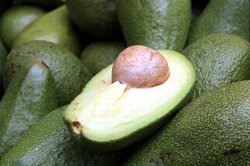 The avocado (Persea americana Mill.) is a nutritious fruit, rich in unsaturated fatty acids and hydro-soluble vitamins, especially A and C, in addition it is poor in sugar content it is recommended for diabetic people. It can be consumed in salads or served as dessert.
The avocado (Persea americana Mill.) is a nutritious fruit, rich in unsaturated fatty acids and hydro-soluble vitamins, especially A and C, in addition it is poor in sugar content it is recommended for diabetic people. It can be consumed in salads or served as dessert. The largest world producer is Mexico, while Brazil is in 4th place with a production of about 170,000 tons in an area of 12,000 ha.
Fruits processed for the fresh-cut chain are subjected to different operations, such as produce selection, washing, peeling, cutting, and packaging, at the end of processing a product has been obtained that is 100% usable, convenient, fresh with a high nutritional quality. Being fresh-cut avocado a fresh fruit, must be stored at lower temperatures (=cold chain) to maintain the sensorial and organoleptic characteristics and to control microbial contamination. The darkening and the softening of pulp are the main limiting factors to the commercialization of fresh-cut fruit and vegetables. The appearance is the first factor that determines the acceptability or rejection of the foods. Furthermore, maintaining the original color during both the processing and storage is the most important and difficult objective for the processors.
The darkening of the avocado pulp is one of the main problems during shelf-life. This alteration is due to polyphenol oxidase (PPO) and peroxidase (PER) enzymes that, in presence of oxygen, catalyze the oxidation of phenols in quinones, which polimerize causing the tissue browning. The darkening can be controlled only processing and storing the fruits at lower temperatures, also the use of chemical additives to be effective must be combined with low temperatures.
The research
The objective of the study conducted by Pinheiro et al. (2009) was to verify the effect of different storage temperatures (0, 5, 10°C) on the maintenance of quality of fresh-cut avocado.
For the research, the fruits used were ‘Fortune’ avocado with average diameter, weight, firmness and dry matter values of 9 cm, 550-650 g, 3 N, and 17-21%, respectively.
Fruits were washed and stored for 12 h at 10°C before the processing. Later, they were immersed for 15 min in a hypochlorite solution with 190 ppm of total residual chlorine, soon afterwards, the stalk insertion extremity was removed, the fruit halved longitudinally and the pit and peel were manually removed. To prevent tissue darkening, the halves were immersed in solution of 0.5% calcium chlorite + 0.5% cysteine chlorohydrate for 2 min, then were packaged and stored for 6 days, during which 5 analysis periods occurred (0, 2, 3, 5 and 6 days of storage).
The analysis consisted of following evaluations:
- pulp color (L*value) to evaluate pulp darkening, L*value varied from white (value = 100) to black (value= 0),
- sensorial analysis of appearance acceptance, flavor and even purchase intention, which were evaluated according to an hedonic scale (9= extremely liked; 1=extremely disliked),
- polyphenol oxidase (PPO) and peroxidase (PER) enzyme activity, and 4) pulp firmness.
The pulp color was significantly influenced by the interaction between temperature and storage time. The L*value of fruits stored at 10°C was lower than fruits stored at 0 and 5°C. After 3 days, fruits stored at 10°C showed a higher darkening (L*Value <70) and its quality, in terms of appearance (<6) and purchase intention, was seriously compromised.
The fruits stored at 5°C showed, on average, from 0 to the 5th day of storage an appearance grade between 8.5 and 7.5 and a purchase intention from 92% to 86%.
The enzymatic activity resulted correlated to the pulp darkening, it increased during storage, especially in fruits stored at 10°C. The halves stored at 5°C showed a higher firmness stability during the storage compared to the fruits stored at 0 and 10 °C. At 0 day, the pulp firmness was about 3-3.5 N and it decreased up to 2.2 N at the end of storage (6th day) in fruits stored at 5°C, while it decreased up to 1.5 N in fruits stored at 0 and 10°C.
According to these results, the scientists recommended to store fresh-cut avocado at 5°C to preserve its sensorial quality for 5-day shelf-life.


